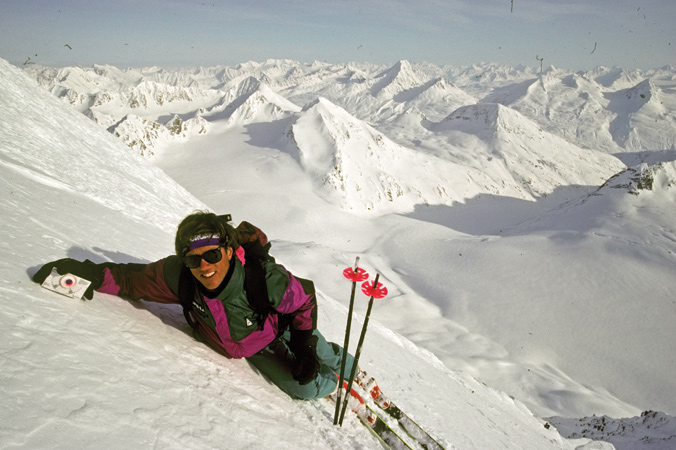Thirty-eight degrees is widely considered the slope angle at which most avalanches occur. But what exactly does a 38-degree slope look like? Calculating slope angle is relatively simple with an inclinometer, which, turns out, is one of the most affordable and compact items you can add to your kit.

Rumor has it Doug Coombs was born with an inclinometer in his right hand. Valdez, Alaska. [Photo] Wade McKoy
Slope angles are measured from a horizontal plane. And while factors like snow structure and terrain features influence how and where avalanches happen, steepness is a major player. In general, slab avalanches commonly occur on slopes between 30 and 45 degrees, focused on the 35-to-40-degree range. (For comparison’s sake, a typical staircase pitches between 30 and 35 degrees.) Though possible under certain conditions, it’s unlikely for avalanches to occur on slopes measuring less than 30 degrees, and, on slopes steeper than 45 degrees, loose-snow avalanches are much more common than slab avalanches.
Measure Thrice
Slope angle can be measured in three ways. A contact measurement—helpful when digging a snow pit or making other in-the-snow analyses—is taken directly on a slope by positioning the inclinometer in line with a ski pole or probe that’s in contact with the snow, pointing down the fall line. A profile measurement—helpful when approaching a slope—can be taken by sighting said slope from the side. And a line-of-sight measurement is best taken from either beneath or above a slope, sighting directly up or down the fall line.
Alpha Angles
Understanding slope angle helps you determine the likelihood that a slope can slide. An alpha angle, on the other hand, helps you determine if you’re in a safe location, far enough below a run-out zone, should a slope slide. This angle is calculated with a line-of-sight measurement from the bottom of a slope to its highest possible start zone—the lower the number, the farther you are from the run-out zone. Appropriate alpha angles vary based on the snowpacks of different climates, but an angle lower than 18 degrees is generally considered safe.
Trusty Tools
Most inclinometers are either super affordable (like Backcountry Access’s $25 business-card-sized Slope Meter) or integrated into another useful mountain tool. Mirror-equipped compasses, like the Suunto MC-2 or Silva Guide, work for all three slope-measurement techniques. Several LockJaw ski poles from K2 include inclinometers built into the grip, or check out PoleClinometer, a Kickstarter-funded $12 sticker package that enables slope measurements with any ski pole. Various phone apps can calculate slope angle, too. Whichever tool you choose, use it often, and identifying a 38-degree slope will feel as natural as skiing one.











Maybe consider smart phone inclinometers, like the Avalanche Inclinometer (AvalancheInclinometer.com). It also shows the elevation, aspect, and GPS location (in addition to the slope angle).
Here are some recommendations for measuring the slope inclination on this page: vigordigital.com/Products.html?product_category=28.